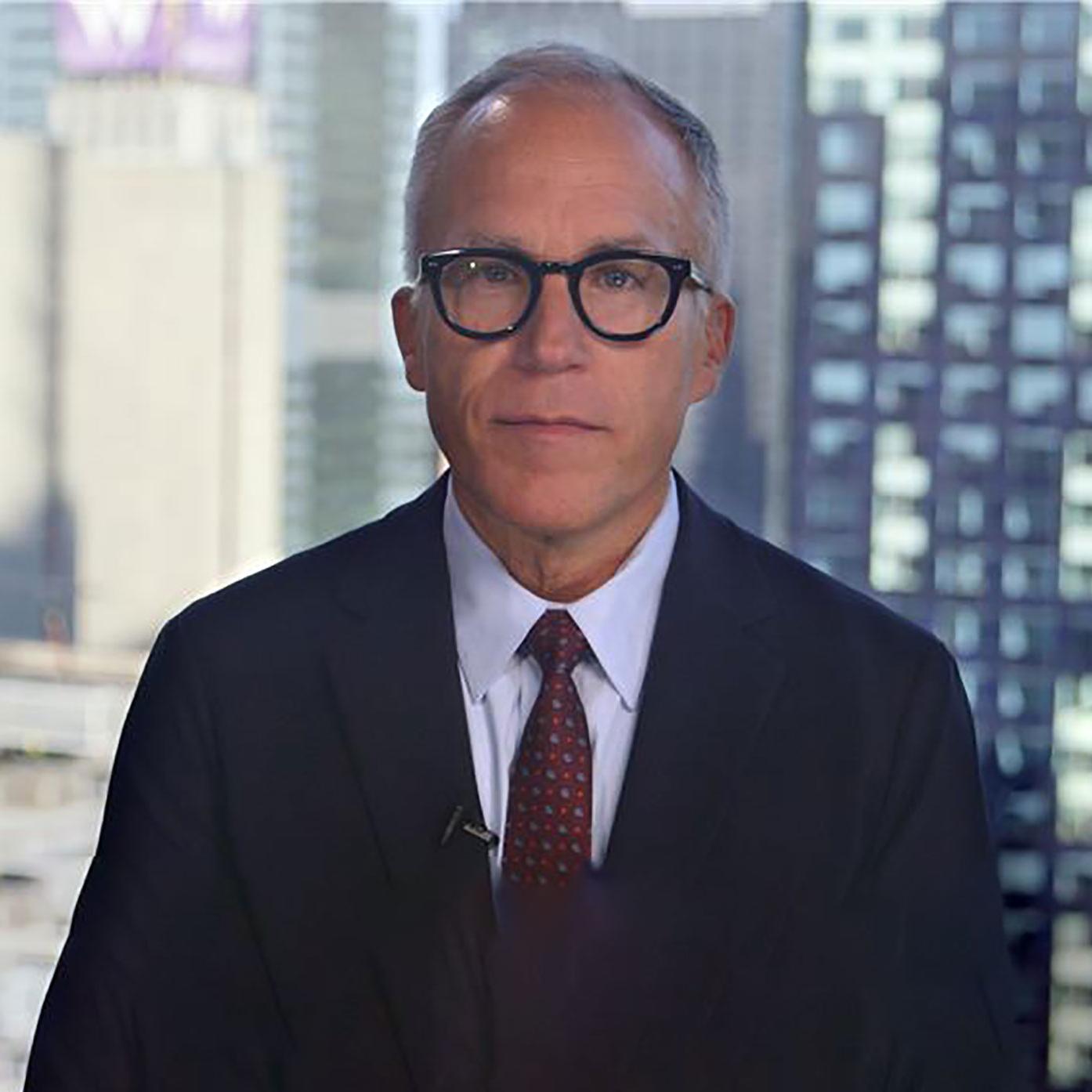
Innovations in Long-Duration Energy Storage
- Courriel
-
Signet
-
Imprimer
Renewable energy generation continues to grow and increases the need to store energy efficiently and economically for longer durations of time. In the latest episode of Sustainability Leaders, I explore how zinc-based batteries and storage assets could complement lithium-ion battery chemistries. My guest on the podcast is James Larsen, CEO of e-Zinc, an energy storage technology developer with projects in Canada and the US.
“At the stage we're at right now, the modest amount of renewable energy we actually have on the grid, it only really necessitates energy storage assets that have the ability to discharge energy for a few hours,” Larsen said.
“But if you extrapolate out the curve and really think about what does 2030 look like, what does 2040 look like, and beyond, and think about the volume of renewable energy that's coming on line, it's going to create more and more significant imbalances between that supply and demand.”
James Larsen:
If you take a one megawatt lithium-ion battery, it can deliver one megawatt for two hours. Now, if you wanted four megawatt hours or six megawatt hours, or eight megawatt hours, you just have to buy more batteries. You got to buy a second and a third one, fourth one. And you're not just getting more energy, you're actually getting more power as well, but you may not actually require that power. You actually just want more duration. And so, you're inadvertently paying for that power. And that's a cost. Really, the economic way of serving a long duration application is to decouple power from energy in order to be able to scale energy independently of power. And that is the premise for e-Zinc's technology.
Michael Torrance:
Welcome to Sustainability Leaders. I'm Michael Torrance, Chief Sustainability Officer at BMO. On this show, we will talk with leading sustainability practitioners from the corporate, investor, academic, and NGO communities, to explore how this rapidly-evolving field of sustainability is impacting global investment, business practices, and our world.
Speaker 3:
The views expressed here are those of the participants and not those of Bank of Montreal, its affiliates or subsidiaries.
Jayen Veerapen:
Hello, all. My name is Jayen Veerapen. I'm a senior advisor with BMO Climate Institute. On this episode of Sustainability Leaders, I have the pleasure to welcome James Larsen, CEO of e-Zinc, a Toronto-based innovative energy storage company with facilities and projects in both Canada and the USA. In our discussion today, James and I will focus on James' journey as an entrepreneur in clean technology, energy storage as a key enabler for the energy transition, and e-Zinc's graph from scientific research to commercialization. James, welcome to the show. And thank you so much for being here today. Would you please introduce yourself and e-Zinc, the company you've been heading since 2018?
James Larsen:
Yeah. Thanks so much, Jayen. My name is James Larsen, I'm the CEO of e-Zinc. E-Zinc is a Toronto-based, well, actually, now Mississauga-based energy storage technology developer. And we have a proprietary zinc-based energy storage solution, which is focused on long duration applications. Really what that means is traditional forms of energy storage, like lithium-ion batteries, they have a few hours at rated capacity, whereas our technology can store energy for multiple days.
Jayen Veerapen:
So, before diving deeper into e-Zinc and energy storage, James, I would be interested to hear about your own journey from a well-established career in the corporate world to the less predictable world of entrepreneurship. Can you tell us a little bit more about that journey?
James Larsen:
Certainly. So, I mean, the journey started a long time ago, even before going into my formal engineering education, because I've always really wanted to be at the intersection of technology, entrepreneurship, and sustainability. And I took engineering because I really wanted to hone my technical skills. And after that, worked in the hydrogen fuel cell industry for a period of time. I then did project engineering and project management for a while. Then did my MBA, and following that, worked in the business world. I worked at Bain & Company, doing management consulting.
And so, after about eight months, I was networking a lot with MaRS Discovery District at that time. And serendipitously an opportunity arose for me to lead a new for-profit business line within MaRS, which is a not-for-profit, so doing consulting in the energy transition space. So, I started doing that, working with utilities around North and South America.
And interestingly, a number of the projects actually ended up being centered around energy storage. And through that, I started becoming very familiar with the technologies, and the market opportunity, and could really see that this was a tidal wave coming at us. And specifically, that long duration storage was going to be this class of energy storage technology that was truly different and had a differentiated position in the market. And so, after a couple of years of that consulting work, again, very serendipitously, I was introduced to the late founder of e-Zinc, Dr. Gregory Zahn. And here in my backyard, in Etobicoke at the time, was this fantastic breakthrough technology, zinc-based energy storage technology focused on long duration.
Jayen Veerapen:
And just for the benefit of our audience, James, MaRS is an accelerator based in Toronto; is that correct?
James Larsen:
Yeah, that's right. So, MaRS is an innovation hub based in Toronto. It's actually North America's largest innovation hub by square footage. There's I think somewhere in the range of almost 1,500 portfolio companies there. So, it was a great platform for me to get more exposed to the startup ecosystem, and it was a really phenomenal experience.
Jayen Veerapen:
Let's focus a little bit more on energy storage, James, which is a sector in which e-Zinc operates. Can you tell us a little bit more what is energy storage and why it is important currently?
James Larsen:
So, energy storage, it's an interesting term. A lot of people immediately go to batteries, but it's much broader than that. Ultimately, what we're trying to do is store energy. And that could be through a variety of different technology classes. The most ubiquitous, the largest market share is actually pumped hydro, but batteries do make up a very significant share and are the fastest growing segment within that. Now, the purpose of energy storage is really moving electrons around, and trying to balance supply and demand. And really, why that's so important for our future is as we think about the proliferation of renewable energy, electrons coming from solar or wind, where the generation of those electrons is unpredictable, it really necessitates having an asset like energy storage in order to balance out that supply with the demand.
And again, as I was saying, the thing with renewable energy is that, at the stage we're at right now, the modest amount of renewable energy we actually have on the grid, it only really necessitates energy storage assets that have the ability to discharge energy for a few hours. But if you extrapolate out the curve and really think about what does 2030 look like, what does 2040 look like, and beyond, and think about the volume of renewable energy that's coming online, it's going to create more and more significant imbalances between that supply and demand. And therefore, necessitate longer and longer duration from energy storage assets. And so, that's really the market opportunity that we're going after. This is not where the puck is, this is where the puck is going. And it's a very exciting place to play.
Jayen Veerapen:
And when we talk about long duration energy storage, how many hours of energy storage we're talking about?
James Larsen:
Yeah, great question. So, I have my own framework for this. I like to think of four broad categories of storage. So, there's the short duration. This is the most common. This is where lithium-ion batteries play and other batteries of that ilk. And this is serving applications like EVs and basic grid services. And batteries are actually doing a great job with that. And there's some other technologies that serve that. The next category is what I call mid-duration, and that's in the four hours to half a day mark. The technologies that serve that space and predominantly flow batteries, and there's some other technologies, of course, but those applications are really around load shifting.
So, shifting, let's say multiple hours, I would say like half a day of solar and shifting it to evening time. And that's a very important application as well. Then you get into long duration storage. And so, I think of this as half a day or longer. And really, it's more like half a day to about 100 hours. Here you're talking about a variety of different applications, let's say like providing backup power to customers that have vulnerability with respect to their energy supply. And then, obviously, what we were talking about earlier, which is supporting the adoption of renewable energy.
Then the fourth category would be ultra long duration storage. And so, I'm really talking about 100 hour plus. So, you're even talking about weekly or monthly, or seasonal storage in some cases. Because if you look at markets, let's say like California, wind and solar are actually coincident. Normally, wind and solar are balancing each other out because wind peaks in the winter and summer peaks in the summer. But in California, those are the same season. So, no matter how much wind and solar you build, what are you going to do in the winter? And so, you need something to shift the energy across those seasons. So, those are the four main categories.
And e-Zinc right now is really playing in that third category, long duration storage. We talk about ourselves as a 12 to 100 hour technology, but the technology actually has the ability to do longer durations. It's just that that fourth category, that ultra long duration market really hasn't emerged yet.
Jayen Veerapen:
And it's interesting, James, you mentioned, you alluded to the different types of energy storage. Two broad categories that we can also talk about is stationary energy storage and energy storage when we talk about electric vehicles. And from what I understand, e-Zinc is really stationary storage part of energy storage business; is that correct?
James Larsen:
Yeah, thanks for bringing that up. I skipped ahead. You're totally right. Well, in fact, actually there's one more category, which would be in the mobile device segment. But mobile devices, like laptops, phones, et cetera, then mobility, like electric vehicles, and then, of course, stationary. And yes, e-Zinc is definitely focused on the stationary storage segment.
Jayen Veerapen:
So, when people hear about energy storage, and you've talked about that, again, they think of lithium batteries. E-Zinc, as its name implies, has chosen a different route. Tell us a little bit more about your technology. How does it work and what stage of development are you at?
James Larsen:
So, e-Zinc's technology is truly unique, but I need to set the table a little bit before I talk about the technology specifically. When thinking about market applications for energy storage, serving the long duration storage segment, that third category and fourth category that I was talking about, it really necessitates a technology that has the economics to support it. Now, every energy storage technology has two ratings. They have a power rating and an energy rating. Energy is how much power the technology can deliver over time. And a lot of technologies, those two ratings are coupled. It's a fixed ratio. So, if you take a lithium-ion battery, let's say it's a one megawatt lithium-ion battery, it might be two megawatt hours of energy, so it can deliver one megawatt for two hours.
Now, if you wanted four megawatt hours or six megawatt hours, or eight megawatt hours, you just have to buy more batteries. You got to buy a second and a third one, fourth one. And you're not just getting more energy, you're actually getting more power as well. But you may not actually require that power. You actually just want more duration. And so, you're inadvertently paying for that power, and that's a cost. Really, the economic way of serving a long duration application is to decouple power from energy in order to be able to scale energy independently of power. And that is the premise for e-Zinc's technology. So, we are an electrochemical system, however, we operate more like a machine. And we have a truly decoupled nature.
So, the technology is a cell-based system. And our cells are much bigger than traditional battery cells. Our cells look more like small fish tanks, actually. And inside of those fish tanks, we have a series of electrodes at the top, and we have an electrode that covers the footprint or the base of the cell. And the whole cell is filled in a bath of electrolyte with dissolved zinc in it. So, what happens is when we inject energy into the cell, the zinc precipitates out on the electrodes at the top of the cell. And we have a wiping mechanism that actually wipes the zinc off of those electrodes. And the zinc falls under its own weight, via gravity, down and collects in the bottom of the cell. So, it settles there like snow, and it creates a bed on top of the electrode of the base.
That physical zinc metal is the stored energy. Now, when we need the energy, we inject air into the cell. The oxygen dissolves the zinc back into the electrolyte. And the dissolution of the zinc is what frees the electricity, allowing us to discharge. And now that the zinc has re-dissolved back into the electrolyte, the whole process can be repeated. So, this is indeed a fully rechargeable electrochemical cell. And it's the state change of zinc between dissolved and solid state that acts as the storage mechanism. If I can just use a quick analogy for people. If you think of sugar dissolving in water, imagine if dissolving sugar and water, you could produce energy from that process.
And now imagine you could consume energy to recrystallize that sugar out of the water. So, that's what we're doing. We're just not moving sugar in and out of water, we're moving zinc in and out of electrolyte. Now, here's the kicker. The power of our system is determined by the surface area of the electrodes. The energy of the system is determined by the size of the tank or the size of the cell and the amount of electrolyte in it. So, we have the ability to create different sizes of tanks, depending on the duration the application would call for, and change the duration without changing the electrodes. So, the electrodes are the same. The charging, the discharging, the exact same. So, the power remains the same, but we've changed the duration.
Jayen Veerapen:
So, can you tell us a little bit, James, where you are in your path to reaching a fully commercial product? Right now which projects are you developing? Where are you developing them? And how does that take you towards achieving a commercial product? Because obviously, as a company, as a for-profit organization, you are aiming to achieve a commercial project at the end. So, where are you now in terms of projects and where do you get to the commercial product?
James Larsen:
Yeah, great question. So, I like to think of the commercialization journey as three big buckets. The first bucket is really the prototyping phase, the hard R&D. The second phase is the pilot phase, and then the third phase is really that commercial phase. So, we're right in that second phase. So, we've spent the last many years really working on the hard science, the hard R&D, all of the hard yards to really get the science and technology nailed down. We deployed our first system in the field here in Ontario, out at Woodstock, which was a fantastic technical demonstration of the system. It was a site, a compressed natural gas facility that had a solar array there.
So, we were accepting charge from both solar and the grid. We had two strings of cells out there. Each string had 12 cells, so we were showing multiple cells and multiple strings, and then the power electronics, and our software and controls. So, it was a holistic system. Following that, we raised an A2 round and have now built out our pilot manufacturing facility in Mississauga. So, we moved in late last year, and have just finished the commissioning of this facility. And are now building our first two major pilot projects, one with the California Energy Commission and one with Toyota Tsusho.
So, those projects will both be delivered in 2026. In parallel with that, we're already in the planning process of our first scale production facility, which is how we will be delivering commercial projects. And that is intended to come online in the first quarter of 2027. So, that facility will then do a couple of pilot projects out of that facility, which will enable us to go through a certification and bankability. And 2028 is really when we intend on embarking on that third chapter, will be a fully commercial company.
Jayen Veerapen:
So, you've mentioned that you've just opened a large manufacturing facility. Congratulations on that significant milestone. Can you tell us more about your customer base, both in terms of applications you're targeting and the geographic focus that you are targeting?
James Larsen:
Yeah, absolutely. We like to think of the market opportunity in terms of horizons. And so, the first horizon that we're really focused on is replacing diesel generators as a form of backup power. So, this is our initial focus right now. The project with the California Energy Commission is a perfect example of that. So, in California, because of the wildfires, the utilities are being forced to shut down pockets of the grid for extended periods of time. These are called public safety power shutoffs or PSPS events. And you'd be blown away. The median time of these events last year was 19 hours. So, there is no battery tech out there that can solve that problem. And so, customers are being forced to use diesel generators.
And of course, diesel generators are a pure cost center, but they pollute, they're noisy, et cetera. And so, customers really want a clean, lower cost alternative. So, our technology is that replacement. We can deploy our system, what's called behind the meter, so physically at a customer's site. So, if you picture, let's say a greenhouse operation or a manufacturing site, we literally go right on their site.
So, these are all ways to monetize the system, but then because we have such long duration capacity, in the event of one of these PSPS events, we have the ability to cover that customer through that event. And so, it's the best of both worlds. We can behave like a battery and monetize the system, but we also behave like a diesel generator and cover those backup events. And so, that's how we have a really compelling economic advantage over diesel generators in these applications. Plus, we're clean. So, it's really a strong value proposition. So, that's our initial focus.
Jayen Veerapen:
So, it's interesting and happy to see that your technology has applications in different markets. You're developing projects in Canada, in the US. Obviously, your investors also see a lot of potential for significant market uptake for your technology, since, as you mentioned earlier, that you've had a successful Series A raise. It's been a challenging environment to raise funds for at least a year or even more. What has made e-Zinc so successful in its fundraising? And what tips and advice can you offer to startups in the energy innovation field?
James Larsen:
Yeah. I mean, first and foremost, it's really important to be aware of the market environment. So, if we actually just talk a little bit about the fundraising history, we closed our Series A round in 2022, in the beginning part of, I think Q1 of 2022. And if you'll recall, even in the middle part of that year, you could see the writing on the wall that there was a shift in the climate, pardon the pun, in the macro environment. And so, it was around that time. And even though we had closed that first round, we actually opened up a Series A2 round effectively almost right away that same calendar year. And we did the first close of it one calendar year later.
So, we had funds in the bank, but elected to raise money again while the market was still strong. And I think that that's really a key message for entrepreneurs out there, is raise money when you don't need to. Make sure to be ahead of it, because you never know how ties can change. And my, oh my, the environment for the last, geez, 12, 18 months, has been really, really challenging. And so, that would be my biggest lesson for entrepreneurs.
Jayen Veerapen:
So, if I'm not mistaken, across your whole Series A is that 56 million US dollars that you've raised?
James Larsen:
That's right. I think that's the exact number. Yeah, you've done your research.
Jayen Veerapen:
So, now if we flip the coin on the other side, any advice for investors who have to screen companies' projects in this space? What type of advice will you give to investors themselves?
James Larsen:
For investors? Oh, interesting question. I like that. I mean, I think, ultimately, it's pretty hard to try and cut the wheat from the chaff. All the different technologies out there, all the different companies that are coming up with solutions, there has been a huge expansion of companies that have come to market in this space. And it's because the market opportunity is so huge. I mean, this is a $4 trillion opportunity by 2040, states the Long Duration Energy Storage Council. I mean, that is just a huge prize. So, the market opportunity, there's no question there. And so, really, it's who are going to be the winners? And first of all, I'd say winners, plural. This is not a winner takes all type of market.
The thing with energy storage is that it truly is going to be a Swiss Army knife for the grid, where there are so many different applications already for energy storage. And I think we're really just getting started
But also to realize, as I said, it's winners. It's going to be a mosaic of technologies that end up serving the market. It's not just any one technology. And so, starting to identify technologies for particular market opportunities within this long duration space, I think is key in order to build a portfolio, really, a strategy of technologies to address this massive opportunity.
Jayen Veerapen:
I like the concept of winners with an S. That's really an interesting take. And I agree with you, there will be many solutions and the market is really huge. It's been an absolute pleasure learning more about your own journey and e-Zinc's journey, Jame., anything else that you would want to add?
James Larsen:
Maybe I'll just finish by saying that e-Zinc, we're definitely a vision, mission-based company. We want to enable a fully renewable future and support this energy transition. This is a journey, though, that really takes a village, as they say. And if there's people out there that are interested in learning more, want to connect, want to see how they can be part of this in some way or support in some way, I'm definitely open to that. So, please feel free to reach out. Thank you so much.
Jayen Veerapen:
Thank you, James, for a wonderful conversation. I look forward to continuing to follow e-Zinc's journey.
Michael Torrance:
Thanks for listening to Sustainability Leaders. This podcast is presented by BMO. You can find our show on Apple Podcasts, Spotify, or your favorite podcast player. Press the follow button if you want to get notified when new episodes are published. We value your input, so please leave a rating, review, and any feedback that you might have or visit us at BMO.com/sustainabilityleaders. Our show and resources are produced with support from BMO's marketing team and Puddle Creative. Until next time, thanks for listening and have a great week.
Speaker 5:
For BMO disclosures, please visit bmocm.com/podcast/disclaimer.
-
Temps de lecture
-
Écouter
Arrêter
-
Agrandir | Réduire le texte
Renewable energy generation continues to grow and increases the need to store energy efficiently and economically for longer durations of time. In the latest episode of Sustainability Leaders, I explore how zinc-based batteries and storage assets could complement lithium-ion battery chemistries. My guest on the podcast is James Larsen, CEO of e-Zinc, an energy storage technology developer with projects in Canada and the US.
“At the stage we're at right now, the modest amount of renewable energy we actually have on the grid, it only really necessitates energy storage assets that have the ability to discharge energy for a few hours,” Larsen said.
“But if you extrapolate out the curve and really think about what does 2030 look like, what does 2040 look like, and beyond, and think about the volume of renewable energy that's coming on line, it's going to create more and more significant imbalances between that supply and demand.”
James Larsen:
If you take a one megawatt lithium-ion battery, it can deliver one megawatt for two hours. Now, if you wanted four megawatt hours or six megawatt hours, or eight megawatt hours, you just have to buy more batteries. You got to buy a second and a third one, fourth one. And you're not just getting more energy, you're actually getting more power as well, but you may not actually require that power. You actually just want more duration. And so, you're inadvertently paying for that power. And that's a cost. Really, the economic way of serving a long duration application is to decouple power from energy in order to be able to scale energy independently of power. And that is the premise for e-Zinc's technology.
Michael Torrance:
Welcome to Sustainability Leaders. I'm Michael Torrance, Chief Sustainability Officer at BMO. On this show, we will talk with leading sustainability practitioners from the corporate, investor, academic, and NGO communities, to explore how this rapidly-evolving field of sustainability is impacting global investment, business practices, and our world.
Speaker 3:
The views expressed here are those of the participants and not those of Bank of Montreal, its affiliates or subsidiaries.
Jayen Veerapen:
Hello, all. My name is Jayen Veerapen. I'm a senior advisor with BMO Climate Institute. On this episode of Sustainability Leaders, I have the pleasure to welcome James Larsen, CEO of e-Zinc, a Toronto-based innovative energy storage company with facilities and projects in both Canada and the USA. In our discussion today, James and I will focus on James' journey as an entrepreneur in clean technology, energy storage as a key enabler for the energy transition, and e-Zinc's graph from scientific research to commercialization. James, welcome to the show. And thank you so much for being here today. Would you please introduce yourself and e-Zinc, the company you've been heading since 2018?
James Larsen:
Yeah. Thanks so much, Jayen. My name is James Larsen, I'm the CEO of e-Zinc. E-Zinc is a Toronto-based, well, actually, now Mississauga-based energy storage technology developer. And we have a proprietary zinc-based energy storage solution, which is focused on long duration applications. Really what that means is traditional forms of energy storage, like lithium-ion batteries, they have a few hours at rated capacity, whereas our technology can store energy for multiple days.
Jayen Veerapen:
So, before diving deeper into e-Zinc and energy storage, James, I would be interested to hear about your own journey from a well-established career in the corporate world to the less predictable world of entrepreneurship. Can you tell us a little bit more about that journey?
James Larsen:
Certainly. So, I mean, the journey started a long time ago, even before going into my formal engineering education, because I've always really wanted to be at the intersection of technology, entrepreneurship, and sustainability. And I took engineering because I really wanted to hone my technical skills. And after that, worked in the hydrogen fuel cell industry for a period of time. I then did project engineering and project management for a while. Then did my MBA, and following that, worked in the business world. I worked at Bain & Company, doing management consulting.
And so, after about eight months, I was networking a lot with MaRS Discovery District at that time. And serendipitously an opportunity arose for me to lead a new for-profit business line within MaRS, which is a not-for-profit, so doing consulting in the energy transition space. So, I started doing that, working with utilities around North and South America.
And interestingly, a number of the projects actually ended up being centered around energy storage. And through that, I started becoming very familiar with the technologies, and the market opportunity, and could really see that this was a tidal wave coming at us. And specifically, that long duration storage was going to be this class of energy storage technology that was truly different and had a differentiated position in the market. And so, after a couple of years of that consulting work, again, very serendipitously, I was introduced to the late founder of e-Zinc, Dr. Gregory Zahn. And here in my backyard, in Etobicoke at the time, was this fantastic breakthrough technology, zinc-based energy storage technology focused on long duration.
Jayen Veerapen:
And just for the benefit of our audience, James, MaRS is an accelerator based in Toronto; is that correct?
James Larsen:
Yeah, that's right. So, MaRS is an innovation hub based in Toronto. It's actually North America's largest innovation hub by square footage. There's I think somewhere in the range of almost 1,500 portfolio companies there. So, it was a great platform for me to get more exposed to the startup ecosystem, and it was a really phenomenal experience.
Jayen Veerapen:
Let's focus a little bit more on energy storage, James, which is a sector in which e-Zinc operates. Can you tell us a little bit more what is energy storage and why it is important currently?
James Larsen:
So, energy storage, it's an interesting term. A lot of people immediately go to batteries, but it's much broader than that. Ultimately, what we're trying to do is store energy. And that could be through a variety of different technology classes. The most ubiquitous, the largest market share is actually pumped hydro, but batteries do make up a very significant share and are the fastest growing segment within that. Now, the purpose of energy storage is really moving electrons around, and trying to balance supply and demand. And really, why that's so important for our future is as we think about the proliferation of renewable energy, electrons coming from solar or wind, where the generation of those electrons is unpredictable, it really necessitates having an asset like energy storage in order to balance out that supply with the demand.
And again, as I was saying, the thing with renewable energy is that, at the stage we're at right now, the modest amount of renewable energy we actually have on the grid, it only really necessitates energy storage assets that have the ability to discharge energy for a few hours. But if you extrapolate out the curve and really think about what does 2030 look like, what does 2040 look like, and beyond, and think about the volume of renewable energy that's coming online, it's going to create more and more significant imbalances between that supply and demand. And therefore, necessitate longer and longer duration from energy storage assets. And so, that's really the market opportunity that we're going after. This is not where the puck is, this is where the puck is going. And it's a very exciting place to play.
Jayen Veerapen:
And when we talk about long duration energy storage, how many hours of energy storage we're talking about?
James Larsen:
Yeah, great question. So, I have my own framework for this. I like to think of four broad categories of storage. So, there's the short duration. This is the most common. This is where lithium-ion batteries play and other batteries of that ilk. And this is serving applications like EVs and basic grid services. And batteries are actually doing a great job with that. And there's some other technologies that serve that. The next category is what I call mid-duration, and that's in the four hours to half a day mark. The technologies that serve that space and predominantly flow batteries, and there's some other technologies, of course, but those applications are really around load shifting.
So, shifting, let's say multiple hours, I would say like half a day of solar and shifting it to evening time. And that's a very important application as well. Then you get into long duration storage. And so, I think of this as half a day or longer. And really, it's more like half a day to about 100 hours. Here you're talking about a variety of different applications, let's say like providing backup power to customers that have vulnerability with respect to their energy supply. And then, obviously, what we were talking about earlier, which is supporting the adoption of renewable energy.
Then the fourth category would be ultra long duration storage. And so, I'm really talking about 100 hour plus. So, you're even talking about weekly or monthly, or seasonal storage in some cases. Because if you look at markets, let's say like California, wind and solar are actually coincident. Normally, wind and solar are balancing each other out because wind peaks in the winter and summer peaks in the summer. But in California, those are the same season. So, no matter how much wind and solar you build, what are you going to do in the winter? And so, you need something to shift the energy across those seasons. So, those are the four main categories.
And e-Zinc right now is really playing in that third category, long duration storage. We talk about ourselves as a 12 to 100 hour technology, but the technology actually has the ability to do longer durations. It's just that that fourth category, that ultra long duration market really hasn't emerged yet.
Jayen Veerapen:
And it's interesting, James, you mentioned, you alluded to the different types of energy storage. Two broad categories that we can also talk about is stationary energy storage and energy storage when we talk about electric vehicles. And from what I understand, e-Zinc is really stationary storage part of energy storage business; is that correct?
James Larsen:
Yeah, thanks for bringing that up. I skipped ahead. You're totally right. Well, in fact, actually there's one more category, which would be in the mobile device segment. But mobile devices, like laptops, phones, et cetera, then mobility, like electric vehicles, and then, of course, stationary. And yes, e-Zinc is definitely focused on the stationary storage segment.
Jayen Veerapen:
So, when people hear about energy storage, and you've talked about that, again, they think of lithium batteries. E-Zinc, as its name implies, has chosen a different route. Tell us a little bit more about your technology. How does it work and what stage of development are you at?
James Larsen:
So, e-Zinc's technology is truly unique, but I need to set the table a little bit before I talk about the technology specifically. When thinking about market applications for energy storage, serving the long duration storage segment, that third category and fourth category that I was talking about, it really necessitates a technology that has the economics to support it. Now, every energy storage technology has two ratings. They have a power rating and an energy rating. Energy is how much power the technology can deliver over time. And a lot of technologies, those two ratings are coupled. It's a fixed ratio. So, if you take a lithium-ion battery, let's say it's a one megawatt lithium-ion battery, it might be two megawatt hours of energy, so it can deliver one megawatt for two hours.
Now, if you wanted four megawatt hours or six megawatt hours, or eight megawatt hours, you just have to buy more batteries. You got to buy a second and a third one, fourth one. And you're not just getting more energy, you're actually getting more power as well. But you may not actually require that power. You actually just want more duration. And so, you're inadvertently paying for that power, and that's a cost. Really, the economic way of serving a long duration application is to decouple power from energy in order to be able to scale energy independently of power. And that is the premise for e-Zinc's technology. So, we are an electrochemical system, however, we operate more like a machine. And we have a truly decoupled nature.
So, the technology is a cell-based system. And our cells are much bigger than traditional battery cells. Our cells look more like small fish tanks, actually. And inside of those fish tanks, we have a series of electrodes at the top, and we have an electrode that covers the footprint or the base of the cell. And the whole cell is filled in a bath of electrolyte with dissolved zinc in it. So, what happens is when we inject energy into the cell, the zinc precipitates out on the electrodes at the top of the cell. And we have a wiping mechanism that actually wipes the zinc off of those electrodes. And the zinc falls under its own weight, via gravity, down and collects in the bottom of the cell. So, it settles there like snow, and it creates a bed on top of the electrode of the base.
That physical zinc metal is the stored energy. Now, when we need the energy, we inject air into the cell. The oxygen dissolves the zinc back into the electrolyte. And the dissolution of the zinc is what frees the electricity, allowing us to discharge. And now that the zinc has re-dissolved back into the electrolyte, the whole process can be repeated. So, this is indeed a fully rechargeable electrochemical cell. And it's the state change of zinc between dissolved and solid state that acts as the storage mechanism. If I can just use a quick analogy for people. If you think of sugar dissolving in water, imagine if dissolving sugar and water, you could produce energy from that process.
And now imagine you could consume energy to recrystallize that sugar out of the water. So, that's what we're doing. We're just not moving sugar in and out of water, we're moving zinc in and out of electrolyte. Now, here's the kicker. The power of our system is determined by the surface area of the electrodes. The energy of the system is determined by the size of the tank or the size of the cell and the amount of electrolyte in it. So, we have the ability to create different sizes of tanks, depending on the duration the application would call for, and change the duration without changing the electrodes. So, the electrodes are the same. The charging, the discharging, the exact same. So, the power remains the same, but we've changed the duration.
Jayen Veerapen:
So, can you tell us a little bit, James, where you are in your path to reaching a fully commercial product? Right now which projects are you developing? Where are you developing them? And how does that take you towards achieving a commercial product? Because obviously, as a company, as a for-profit organization, you are aiming to achieve a commercial project at the end. So, where are you now in terms of projects and where do you get to the commercial product?
James Larsen:
Yeah, great question. So, I like to think of the commercialization journey as three big buckets. The first bucket is really the prototyping phase, the hard R&D. The second phase is the pilot phase, and then the third phase is really that commercial phase. So, we're right in that second phase. So, we've spent the last many years really working on the hard science, the hard R&D, all of the hard yards to really get the science and technology nailed down. We deployed our first system in the field here in Ontario, out at Woodstock, which was a fantastic technical demonstration of the system. It was a site, a compressed natural gas facility that had a solar array there.
So, we were accepting charge from both solar and the grid. We had two strings of cells out there. Each string had 12 cells, so we were showing multiple cells and multiple strings, and then the power electronics, and our software and controls. So, it was a holistic system. Following that, we raised an A2 round and have now built out our pilot manufacturing facility in Mississauga. So, we moved in late last year, and have just finished the commissioning of this facility. And are now building our first two major pilot projects, one with the California Energy Commission and one with Toyota Tsusho.
So, those projects will both be delivered in 2026. In parallel with that, we're already in the planning process of our first scale production facility, which is how we will be delivering commercial projects. And that is intended to come online in the first quarter of 2027. So, that facility will then do a couple of pilot projects out of that facility, which will enable us to go through a certification and bankability. And 2028 is really when we intend on embarking on that third chapter, will be a fully commercial company.
Jayen Veerapen:
So, you've mentioned that you've just opened a large manufacturing facility. Congratulations on that significant milestone. Can you tell us more about your customer base, both in terms of applications you're targeting and the geographic focus that you are targeting?
James Larsen:
Yeah, absolutely. We like to think of the market opportunity in terms of horizons. And so, the first horizon that we're really focused on is replacing diesel generators as a form of backup power. So, this is our initial focus right now. The project with the California Energy Commission is a perfect example of that. So, in California, because of the wildfires, the utilities are being forced to shut down pockets of the grid for extended periods of time. These are called public safety power shutoffs or PSPS events. And you'd be blown away. The median time of these events last year was 19 hours. So, there is no battery tech out there that can solve that problem. And so, customers are being forced to use diesel generators.
And of course, diesel generators are a pure cost center, but they pollute, they're noisy, et cetera. And so, customers really want a clean, lower cost alternative. So, our technology is that replacement. We can deploy our system, what's called behind the meter, so physically at a customer's site. So, if you picture, let's say a greenhouse operation or a manufacturing site, we literally go right on their site.
So, these are all ways to monetize the system, but then because we have such long duration capacity, in the event of one of these PSPS events, we have the ability to cover that customer through that event. And so, it's the best of both worlds. We can behave like a battery and monetize the system, but we also behave like a diesel generator and cover those backup events. And so, that's how we have a really compelling economic advantage over diesel generators in these applications. Plus, we're clean. So, it's really a strong value proposition. So, that's our initial focus.
Jayen Veerapen:
So, it's interesting and happy to see that your technology has applications in different markets. You're developing projects in Canada, in the US. Obviously, your investors also see a lot of potential for significant market uptake for your technology, since, as you mentioned earlier, that you've had a successful Series A raise. It's been a challenging environment to raise funds for at least a year or even more. What has made e-Zinc so successful in its fundraising? And what tips and advice can you offer to startups in the energy innovation field?
James Larsen:
Yeah. I mean, first and foremost, it's really important to be aware of the market environment. So, if we actually just talk a little bit about the fundraising history, we closed our Series A round in 2022, in the beginning part of, I think Q1 of 2022. And if you'll recall, even in the middle part of that year, you could see the writing on the wall that there was a shift in the climate, pardon the pun, in the macro environment. And so, it was around that time. And even though we had closed that first round, we actually opened up a Series A2 round effectively almost right away that same calendar year. And we did the first close of it one calendar year later.
So, we had funds in the bank, but elected to raise money again while the market was still strong. And I think that that's really a key message for entrepreneurs out there, is raise money when you don't need to. Make sure to be ahead of it, because you never know how ties can change. And my, oh my, the environment for the last, geez, 12, 18 months, has been really, really challenging. And so, that would be my biggest lesson for entrepreneurs.
Jayen Veerapen:
So, if I'm not mistaken, across your whole Series A is that 56 million US dollars that you've raised?
James Larsen:
That's right. I think that's the exact number. Yeah, you've done your research.
Jayen Veerapen:
So, now if we flip the coin on the other side, any advice for investors who have to screen companies' projects in this space? What type of advice will you give to investors themselves?
James Larsen:
For investors? Oh, interesting question. I like that. I mean, I think, ultimately, it's pretty hard to try and cut the wheat from the chaff. All the different technologies out there, all the different companies that are coming up with solutions, there has been a huge expansion of companies that have come to market in this space. And it's because the market opportunity is so huge. I mean, this is a $4 trillion opportunity by 2040, states the Long Duration Energy Storage Council. I mean, that is just a huge prize. So, the market opportunity, there's no question there. And so, really, it's who are going to be the winners? And first of all, I'd say winners, plural. This is not a winner takes all type of market.
The thing with energy storage is that it truly is going to be a Swiss Army knife for the grid, where there are so many different applications already for energy storage. And I think we're really just getting started
But also to realize, as I said, it's winners. It's going to be a mosaic of technologies that end up serving the market. It's not just any one technology. And so, starting to identify technologies for particular market opportunities within this long duration space, I think is key in order to build a portfolio, really, a strategy of technologies to address this massive opportunity.
Jayen Veerapen:
I like the concept of winners with an S. That's really an interesting take. And I agree with you, there will be many solutions and the market is really huge. It's been an absolute pleasure learning more about your own journey and e-Zinc's journey, Jame., anything else that you would want to add?
James Larsen:
Maybe I'll just finish by saying that e-Zinc, we're definitely a vision, mission-based company. We want to enable a fully renewable future and support this energy transition. This is a journey, though, that really takes a village, as they say. And if there's people out there that are interested in learning more, want to connect, want to see how they can be part of this in some way or support in some way, I'm definitely open to that. So, please feel free to reach out. Thank you so much.
Jayen Veerapen:
Thank you, James, for a wonderful conversation. I look forward to continuing to follow e-Zinc's journey.
Michael Torrance:
Thanks for listening to Sustainability Leaders. This podcast is presented by BMO. You can find our show on Apple Podcasts, Spotify, or your favorite podcast player. Press the follow button if you want to get notified when new episodes are published. We value your input, so please leave a rating, review, and any feedback that you might have or visit us at BMO.com/sustainabilityleaders. Our show and resources are produced with support from BMO's marketing team and Puddle Creative. Until next time, thanks for listening and have a great week.
Speaker 5:
For BMO disclosures, please visit bmocm.com/podcast/disclaimer.
Autre contenu intéressant

Tom Steyer : Les solutions climatiques devraient rendre la vie plus facile et meilleure
Un plus grand nombre d’entreprises américaines et canadiennes se tournent vers la lutte contre les changements climatiques en raison des attentes de leurs clients : Résultats du sondage
L’importance croissante de la résilience des chaînes d’approvisionnement

L’aspect économique de l’élimination du carbone : un entretien avec Deep Sky

Financement des minéraux critiques : Occasions d’élaborer de nouveaux cadres de placement

Élargissement de l’accès à l’énergie solaire : Leçons tirées par GRID Alternatives

Validating Breakthrough Energy Concepts, a Discussion with George Hathaway

How Developers and Builders Are Paving the Way for a Greener Future

From Farm to Future: How Funding Solutions are Shaping Agricultural Emissions
Questions et réponses : Pourquoi la déclaration volontaire des émissions devrait-elle être une priorité?
Pourquoi la durabilité est une source de bonnes affaires : Principaux points retenus du Forum économique international des Amériques (FEIA) de 2024, à Toronto
Comprendre l’incidence de la biodiversité sur les entreprises

Building for Tomorrow: Real Estate, Construction, and Sustainability
Les femmes entrepreneures favorisent la durabilité : réflexion sur les résultats du défi WE Empower lié aux objectifs de développement durable des Nations Unies
Pourquoi une politique liée à la chaleur extrême est importante pour les entreprises
Stratégies climatiques dans le secteur de l’immobilier commercial : gérer les risques

Immeubles résidentiels à logements multiples carboneutres au Canada : Analyse du coût et de la valeur de l’actif

BMO Equity Research on the AI + Data Center Build Out: Sustainability Impacts, Second Order Beneficiaries

Le coût des risques climatiques dans le secteur agricole aux États-Unis

Making Renewable Energy Technology Accessible to Underserved Communities: GRID Alternatives in Conversation

Comptabilisation du carbone : Comment renforcer les plans climatiques des entreprises

Les progrès de la technologie des batteries alimentent l’optimisme au sujet de l’industrie des VE

Les femmes jouent un rôle de premier plan dans le domaine du climat et du développement durable

Le rôle de l’exploitation minière responsable dans la transition vers les énergies propres : entretien avec Rohitesh Dhawan, chef de la direction de l’ICMM
Décloisonner le développement durable pour l’intégrer aux fonctions de base

Températures extrêmes : comment les villes nord-américaines amplifient-elles le changement climatique?

Questions climatiques : rôle de plus en plus important des hauts dirigeants

Transforming the Textile Industry: Apparel Impact Institute in Conversation
Trois idées inspirées de la Semaine du climat pour passer à l’action à la COP28

Protecting Outdoor Spaces: The Conservation Alliance in Conversation

Building Meaningful Connections with Nature: Parks California in Conversation

Comment les investissements dans le captage du carbone peuvent générer des crédits carbone

Free, Prior and Informed Consent (FPIC): Mark Podlasly in Conversation

Comment les concessionnaires automobiles contribuent à la transition vers la carboneutralité

Les feux de forêt au Canada brûlent toujours: explications d’experts

Quick Listen: Michael Torrance on Empowering Your Organization to Operationalize Sustainability

Quick Listen: Darryl White on the Importance of US-Canada Partnership

North America’s Critical Minerals Advantage: Deep Dive on Community Engagement

Evolving Mining for a Sustainable Energy Transition: ICMM CEO Rohitesh Dhawan in Conversation

BMO Equity Research on BMO Radicle and the World of Carbon Credits

Public Policy and the Energy Transition: Howard Learner in Conversation

Taskforce on Nature-Related Financial Disclosure (TNFD) – A Plan for Integrating Nature into Business

ESG Trends in the Base Metal and Diversified Mining Industries: BMO Equity Research Report

COP27 : Les problèmes de sécurité énergétique et l’incertitude économique ralentiront-t-ils la transition climatique?

RoadMap Project: An Indigenous-led Paradigm Shift for Economic Reconciliation

On-Farm Carbon and Emissions Management: Opportunities and Challenges

Intégration des facteurs ESG dans les petites et moyennes entreprises : Conférence de Montréal

Investment Opportunities for a Net-Zero Economy: A Conversation at the Milken Institute Global Conference

How Hope, Grit, and a Hospital Network Saved Maverix Private Capital Founder John Ruffolo

Hydrogen’s Role in the Energy Transition: Matt Fairley in Conversation

Key Takeaways on Ag, Food, Fertilizer & ESG from BMO’s Farm to Market Conference

Building an ESG Business Case in the Food Sector: The Food Institute

Financer la transition vers la carboneutralité : une collaboration entre EDC et BMO

Refonte au Canada pour un monde carboneutre : Conversation avec Corey Diamond d’Efficacité énergétique Canada

The Role of Hydrogen in the Energy Transition: FuelCell Energy CEO Jason Few in Conversation


Tackling Climate Change in Metals and Mining: ICMM CEO Rohitesh Dhawan in Conversation

Why Changing Behaviour is Key to a Low Carbon Future – Dan Barclay

The Post 2020 Biodiversity Framework – A Discussion with Basile Van Havre

Using Geospatial Big Data for Climate, Finance and Sustainability

The Global Energy Transition: Darryl White & John Graham Discuss

The Risk of Permafrost Thaw on People, Infrastructure & Our Future Climate

Climate Change & Flood Risk: Implications for Real Estate Markets

Director of ESG at BMO Talks COP26 & the Changing ESG Landscape

Candidature du Canada pour accueillir le nouveau siège social de l'ISSB

Comprendre la Journée nationale de la vérité et de la réconciliation

Comprendre la Journée nationale de la vérité et de la réconciliation

Combler l’écart de richesse entre les groupes raciaux grâce à des actions mesurables

Biggest Trends in Food and Ag, From ESG to Inflation to the Supply Chain

Understanding Biodiversity Management: Best Practices and Innovation

The Changing Face of Sustainability: tentree for a Greener Planet

Favoriser l’autonomisation dans une perspective d’équité raciale et de genre

Episode 31: Valuing Natural Capital – A Discussion with Pavan Sukhdev

Episode 29: What 20 Years of ESG Engagement Can Teach Us About the Future

Episode 28: Bloomberg: Enhancing ESG Disclosure through Data-Driven Solutions

Episode 27: Preventing The Antimicrobial Resistance Health Crisis

Episode 25: Achieving Sustainability In The Food Production System

Episode 23: TC Transcontinental – A Market Leader in Sustainable Packaging

Episode 16: Covid-19 Implications and ESG Funds with Jon Hale

Episode 13: Faire face à la COVID-19 en optant pour des solutions financières durables

Épisode 09 : Le pouvoir de la collaboration en matière d'investissement ESG

Épisode 08 : La tarification des risques climatiques, avec Bob Litterman

Épisode 07 : Mobiliser les marchés des capitaux en faveur d’une finance durable

Épisode 06 : L’investissement responsable – Tendances et pratiques exemplaires canadiennes

Épisode 04 : Divulgation de renseignements relatifs à la durabilité : Utiliser le modèle de SASB

Épisode 03 : Taxonomie verte: le plan d'action pour un financement durable de l'UE

Épisode 02 : Analyser les risques climatiques pour les marchés financiers












